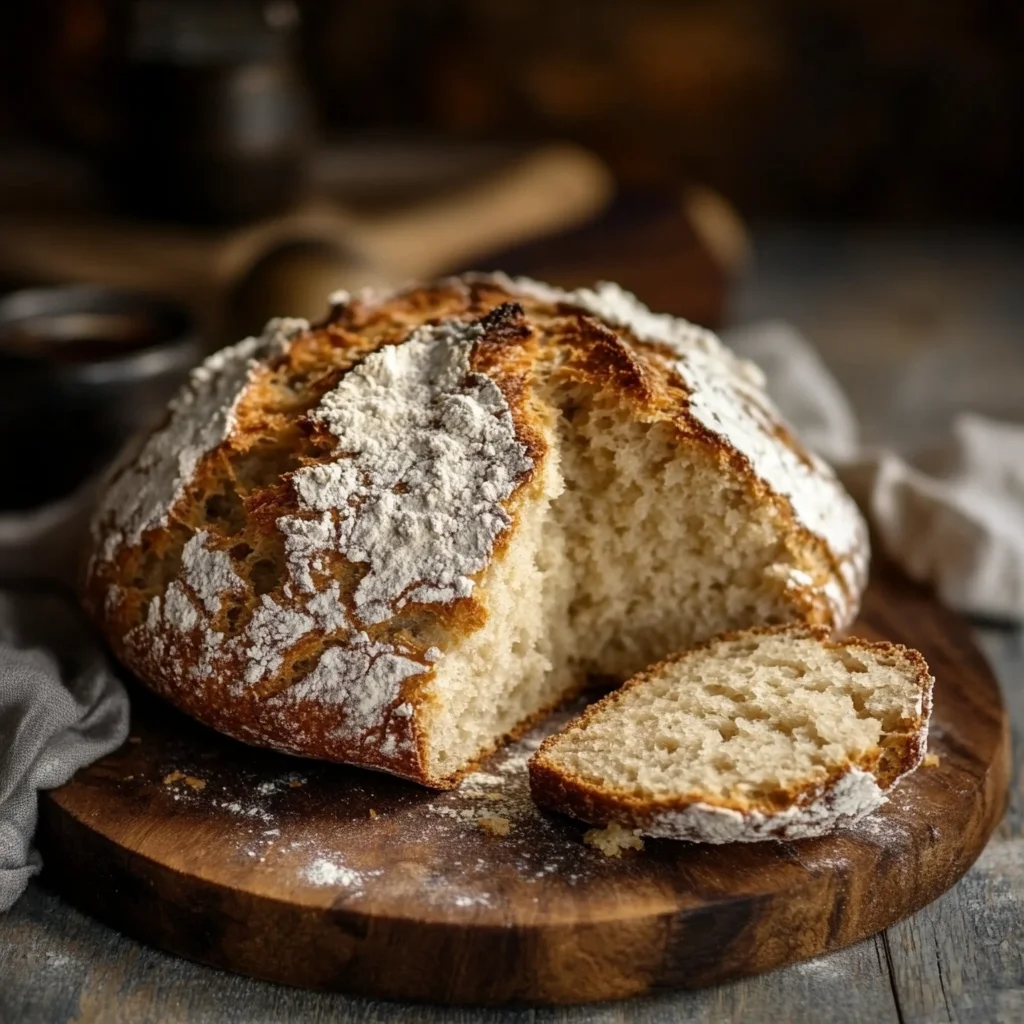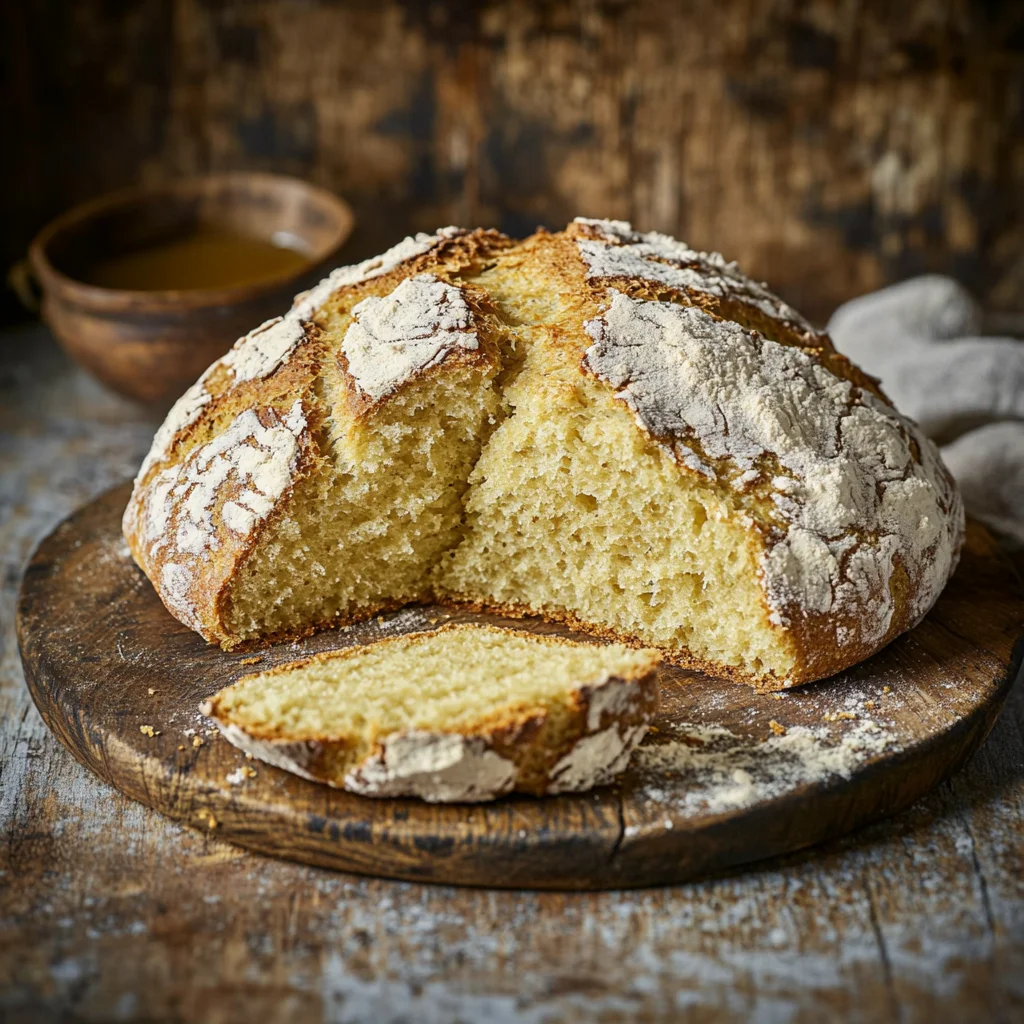When it comes to simple yet delicious homemade bread, Mary Berry’s Soda Bread Recipe is a must-try. Known for her practical and no-fuss approach, Mary Berry has perfected this traditional Irish soda bread, which requires no yeast and minimal effort. The result? A beautiful, rustic loaf with a dense, chewy texture and a slightly tangy flavor, perfect for slathering with butter or serving alongside soups and stews.
Try this nutty and nutritious Dakota Bread Recipe, a great alternative for those seeking a homemade bread option.
This soda bread recipe is ideal for home bakers who are short on time but still crave that fresh-baked bread experience. Whether you’re a novice baker or a seasoned pro, Mary Berry’s method makes it easy to achieve great results every time. Plus, with no need for yeast or proofing, you can have a warm loaf of soda bread on the table in less than an hour.
In this article, we’ll walk you through the entire process of baking Mary Berry’s soda bread from scratch, provide some helpful tips, and explore how you can customize it to suit your dietary needs. You’ll also discover advanced techniques, the nutritional benefits of this bread, and how to store it properly. By the end, you’ll be ready to bake your own fresh loaf of soda bread with confidence.
Benefits and Advantages of Mary Berry’s Soda Bread Recipe
Before diving into the recipe, it’s essential to understand why Mary Berry’s Soda Bread is a go-to recipe for both beginner and experienced bakers. Here are the top benefits of this recipe and why it’s beloved by so many.
1. No Yeast Needed
One of the key benefits of soda bread is that it doesn’t require yeast. Instead of relying on yeast for leavening, this bread uses baking soda and buttermilk. The acid in the buttermilk reacts with the alkaline baking soda to create bubbles of carbon dioxide, which helps the bread rise without needing any time for proofing. This means you can skip the long wait times typically associated with yeast bread. If you’re someone who wants fresh bread without the hassle of dealing with yeast, this recipe is perfect for you.
2. Quick and Easy Preparation
With just a handful of ingredients and no complicated steps, Mary Berry’s soda bread is incredibly easy to prepare. The process, from mixing the dough to baking the loaf, takes less than an hour, making it perfect for busy weekdays or last-minute baking. You don’t need to be an expert baker to pull this off, and the recipe uses ingredients you probably already have in your kitchen, such as flour, baking soda, and buttermilk.
Because there’s no waiting for the dough to rise, soda bread offers the convenience of baking on the fly. Whether you’re preparing breakfast, a snack, or dinner, soda bread is one of the fastest ways to get homemade bread on the table.
3. Versatile and Customizable
While the classic soda bread recipe is delicious on its own, it’s also highly versatile. You can easily customize it by adding various ingredients to suit your taste. Dried fruits, nuts, seeds, herbs, and spices can all be incorporated into the dough to create endless variations. Want a sweeter version? Add raisins or cranberries. Prefer something more savory? Incorporate herbs like rosemary, thyme, or even grated cheese. This versatility allows you to tailor the recipe to your preferences or the occasion.
This recipe’s versatility also extends to dietary needs. Whether you’re gluten-free, dairy-free, or trying to incorporate more whole grains into your diet, soda bread is easy to adapt to different dietary preferences (more on that later!).
4. Health Benefits
Learn more about healthiest bread options on BBC Good Food. Soda bread is a healthier bread option that’s low in fat and sugar while providing essential nutrients.
Soda bread is naturally lower in fat and sugar compared to many other types of bread, especially commercial varieties. It’s made with simple, wholesome ingredients that don’t include preservatives or artificial additives. By using wholemeal flour, you can increase the fiber content, making it a healthier option than white bread.
The buttermilk used in this recipe adds moisture and tang while providing essential nutrients such as calcium and vitamin D. Because the dough doesn’t need to rise, there’s no need for added sugars to feed yeast, which is common in many bread recipes. This makes soda bread a good choice for those looking to reduce their sugar intake.
Explore the quick and easy Creamette Mac and Cheese Recipe, which also comes together in no time with simple ingredients.
Ingredients Overview for Mary Berry’s Soda Bread Recipe
The beauty of this recipe lies in its simplicity. With just a few basic ingredients, you can create a hearty, delicious loaf of bread that’s perfect for any meal. Below, we’ll break down the essential ingredients for this recipe and discuss how each one contributes to the final product.

Essential Ingredients
- 4 cups (500g) plain flour: You can use white flour, wholemeal flour, or a mix of both. Wholemeal flour will give the bread a denser, more rustic texture, while white flour will result in a lighter loaf.
- 1 ½ teaspoons baking soda: This acts as the leavening agent. When it reacts with the acid in the buttermilk, it creates bubbles that help the bread rise.
- 1 teaspoon salt: This enhances the flavor of the bread and helps balance the tanginess of the buttermilk.
- 2 cups (500ml) buttermilk: The acidity in the buttermilk is essential for activating the baking soda, giving the bread its rise and characteristic texture. Buttermilk also adds a rich, tangy flavor.
If you love experimenting with different types of bread, you might also enjoy this soft, buttery Milk Brioche Recipe, which is perfect for breakfast or snacks.
Dietary Substitutions to Customize Your Soda Bread
If you need to cater to specific dietary requirements, there are a few simple substitutions you can make to this soda bread recipe. Below, we’ll outline how you can adapt the recipe to suit various diets, including gluten-free, dairy-free, and whole grain options.
Gluten-Free Option
- Use gluten-free flour: To make this recipe gluten-free, simply swap out the plain flour for a gluten-free flour blend. Gluten-free flour tends to absorb more liquid, so you may need to add a bit more buttermilk to achieve the right dough consistency. Be sure to check that your baking soda and other ingredients are certified gluten-free.
Dairy-Free Alternative
- Use dairy-free milk and lemon juice: If you’re lactose intolerant or following a vegan diet, you can replace the buttermilk with a dairy-free milk alternative, such as almond, soy, or oat milk, mixed with a tablespoon of lemon juice or apple cider vinegar. Let this mixture sit for a few minutes to thicken before adding it to the dough. This dairy-free version will still give you a tangy flavor similar to buttermilk.
- Learn how to make dairy-free buttermilk on The Kitchn, which offers guidance on making a dairy-free buttermilk substitute using plant-based milk.
Whole Grain Option
- Opt for wholemeal flour: For a healthier version of Mary Berry’s soda bread, you can use wholemeal flour instead of plain flour. Wholemeal flour adds more fiber and nutrients to the bread, making it a heartier option. Keep in mind that wholemeal flour will produce a denser loaf, so you may want to mix it with some white flour for a lighter texture.
How to Prepare Mary Berry’s Soda Bread: Step-by-Step Guide
Follow these simple steps to create your own delicious loaf of Mary Berry’s Soda Bread. With minimal effort, you’ll be rewarded with a warm, hearty loaf of bread that’s perfect for any meal.
First Step: Preheat the Oven
Start by preheating your oven to 220°C (425°F). Place a baking sheet in the oven to heat up while you prepare the dough. This ensures that the bottom of the bread gets a nice crust when it bakes.
Second Step: Mix the Dry Ingredients
In a large mixing bowl, combine the flour, baking soda, and salt. Stir them together with a whisk or spoon to ensure the baking soda is evenly distributed throughout the flour. If you’re using wholemeal flour, you may want to sift it first to remove any large bran pieces that could make the bread too dense.
Third Step: Add the Buttermilk
Make a well in the center of the dry ingredients and pour in the buttermilk. Using your hands or a spatula, gently mix the ingredients until they come together to form a sticky dough. Be careful not to overmix, as this can result in a tough loaf. The dough should be soft but not too wet; if it’s too sticky, add a little more flour, but avoid adding too much, or the bread will become dense.
Fourth Step: Shape the Dough
Turn the dough out onto a lightly floured surface and shape it into a round loaf. The dough doesn’t need to be kneaded—just gently shape it into a ball. Place the dough on the preheated baking sheet. Using a sharp knife, cut a deep cross into the top of the dough. This traditional method not only helps the bread bake evenly but also gives it that classic soda bread look.
Fifth Step: Bake the Bread
Place the baking sheet with the dough in the preheated oven and bake for 30-35 minutes, or until the bread is golden brown and sounds hollow when tapped on the bottom. If the top of the bread is browning too quickly, you can cover it with a piece of aluminum foil halfway through the baking time.
Sixth Step: Cool and Serve
Once the bread is fully baked, remove it from the oven and allow it to cool on a wire rack for at least 10 minutes before slicing. Soda bread is best served warm, but it can be enjoyed at room temperature as well. Slice it up and serve with butter, jam, or alongside your favorite soups and stews.
Mastering Mary Berry’s Soda Bread: Advanced Tips and Variations
While Mary Berry’s basic soda bread recipe is easy and foolproof, there are plenty of ways to take it to the next level. Here are some advanced tips and variations to help you perfect your soda bread:
Add Extra Flavor
For a savory twist, try adding chopped fresh herbs such as rosemary, thyme, or parsley to the dough before baking. You can also mix in grated cheese or garlic for added flavor. For a Mediterranean twist, consider adding sun-dried tomatoes and olives to the dough.
Sweeten It Up
If you prefer a sweeter soda bread, you can add a handful of raisins, currants, or dried cranberries to the dough. For an extra touch of sweetness, sprinkle a little sugar or cinnamon on top before baking. You could also drizzle honey or maple syrup over the bread once it’s baked for a sweet finish.
Make Mini Loaves
For individual servings, you can divide the dough into smaller portions and bake them as mini loaves or rolls. These are perfect for lunchboxes, picnics, or serving at a dinner party. They bake more quickly than a large loaf, so keep an eye on them in the oven to prevent overbaking.
Experiment with Flours
While the traditional recipe calls for plain flour or wholemeal flour, you can experiment with other types of flour to create different textures and flavors. Rye flour, spelt flour, or a combination of different flours can add a unique twist to your soda bread.
How to Store Mary Berry’s Soda Bread: Best Practices
Soda bread is best enjoyed fresh, but if you have leftovers, here’s how to store it to keep it tasting great for days to come.
At Room Temperature
Wrap the cooled bread in a clean tea towel or store it in an airtight container at room temperature for up to two days. This will help prevent the bread from drying out while still allowing it to breathe. Avoid storing soda bread in a plastic bag, as this can cause the crust to become soft and chewy.
Refrigeration
If you plan to keep the bread for longer than two days, you can store it in the refrigerator. Wrap it tightly in plastic wrap or foil to prevent it from drying out. Keep in mind that refrigerating bread can cause it to become stale more quickly, so it’s best to eat it within a few days.
Freezing
To freeze soda bread, allow the loaf to cool completely, then wrap it tightly in plastic wrap and place it in a freezer-safe bag or container. It will keep for up to three months in the freezer. When you’re ready to eat it, let the bread thaw at room temperature, then warm it in the oven for a few minutes before slicing.
Nutritional Value of Mary Berry’s Soda Bread Recipe
Here’s a general nutritional breakdown of a slice of soda bread (based on the traditional recipe using white flour and buttermilk):
- Calories: 180
- Protein: 6g
- Carbohydrates: 36g
- Fat: 1.5g
- Fiber: 1g
- Sugar: 2g
This makes soda bread a relatively low-calorie bread option, especially if you opt for wholemeal flour, which will increase the fiber content.
If you are looking for healthier bread alternatives, explore this Tomato Asparagus Pasta Recipe, which pairs wonderfully with freshly baked bread for a light, balanced meal.
Frequently Asked Questions About Mary Berry’s Soda Bread Recipe
Can I Make Soda Bread Without Buttermilk?
Yes, if you don’t have buttermilk, you can make a substitute by mixing 2 cups of milk with 2 tablespoons of lemon juice or vinegar. Let it sit for about 10 minutes to thicken before using it in the recipe. This will give the milk the same tangy acidity as buttermilk, which is crucial for activating the baking soda.
Why Is My Soda Bread Dense?
Soda bread can become dense if you overmix the dough. Be sure to mix the ingredients just until they come together. Avoid kneading the dough too much, as this can cause the bread to become tough. Also, using wholemeal flour will produce a denser loaf than white flour, so you may want to use a mix of both for a lighter texture.
Can I Freeze Soda Bread?
Yes, soda bread freezes well. Simply wrap it tightly in plastic wrap, place it in a freezer-safe bag, and store it in the freezer for up to three months. When you’re ready to eat it, let it thaw at room temperature and warm it up in the oven before serving.
How Long Does Soda Bread Last?
Soda bread is best eaten on the day it’s made, but it will keep for up to two days if stored properly at room temperature. You can also freeze soda bread for up to three months.
Can I Use Other Types of Flour in Soda Bread?
Yes, you can experiment with different types of flour to create different textures and flavors in your soda bread. Rye flour, spelt flour, or even a combination of different flours can add a unique twist to the recipe. Keep in mind that using whole grains or other types of flour may affect the texture of the bread, making it denser.
Conclusion
Mary Berry’s Soda Bread Recipe is a wonderfully simple, quick, and versatile bread that anyone can make. With no yeast required, this recipe is perfect for those who want fresh, homemade bread without the fuss. Whether you’re serving it as a side dish or enjoying it on its own, soda bread is a satisfying, delicious addition to any meal.
The best part is that it’s easily customizable to suit your preferences, whether you prefer a savory or sweet loaf. Plus, with options for gluten-free and dairy-free versions, this recipe can accommodate various dietary needs. Give it a try and discover why this traditional bread has remained a favorite for generations!

